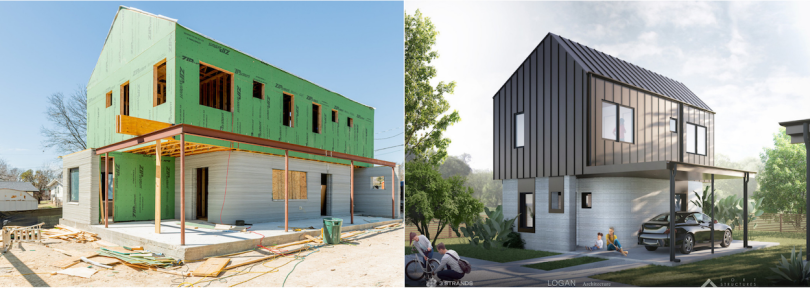
Austin’s ICON has been busy lately, using its proprietary 3D printing technology to break barriers both in space and here on Earth.
The company raised a $35 million Series A round just six months ago, but remained fairly tight lipped about where that funding would be used. It did, however, tease that it would be bringing its tech out of the research and development stage and into the hands of companies, and that it was looking to fill roles in “off-planet construction.”
Now, it looks like some of those plans are beginning to bear fruit. ICON announced this week that its technology has been used to produce the world’s first 3D-printed lunar launch and landing pad at Camp Swift, a Texas Military Department location just outside of Austin.
The project was headed by a team of undergraduate students from 10 colleges and universities around the country — known as the Artemis Generation — who built a subscale prototype pad out of “cement-based material and a gantry print system” developed by ICON.
The concept sets out to solve the problems caused when the force of an engine’s powerful exhaust meets the dusty lunar surface. The design, called the Plume Alleviation Device (Lunar PAD for short), addresses this with a series of petal-like channels that send exhaust upward and outward, thus minimizing the amount of dust expelled during launch and landing.

The students initially proposed the idea for their landing pad in the summer of 2019 during NASA’s Proposal Writing and Evaluation Experience, a 12-week training course headed by John Dankanich, chief technologist at NASA’s Marshall Space Flight Center. Their proposal won funding and support from NASA, and the team managed to secure a second round of funding last June when it was presented to Marshall experts at a virtual design readiness review.
“The proposal addressed a technology pain point, as the project enables a safe and reusable landing pad required for sustainable lunar exploration,” Dankanich said in a statement. “The team worked many hundreds of hours, engaged NASA subject matter experts, and went from concept to formulation to a preliminary design. They turned that design into reality with the subscale construction, all in a few short months.”
This week, the team reunited again to see how their prototype holds up under extreme high temperatures and stresses created by a rocket engine, with the help of Texas A&M’s Sounding Rocketry Team. And it seems that their lunar launch and landing pad performed as designed, bringing humanity one step closer to reliable and sustainable lunar infrastructure.
“This is the first milestone on the journey to making off-world construction a reality, which will allow humanity to stay — not just visit the stars,” Michael McDaniel, ICON’s head of design, said in a statement.

For Sale: 3D Printed Homes
Icon is making moves here on Earth, too, announcing earlier this month that it has partnered with Kansas City-based housing developer 3Strands to build a neighborhood of 3D-printed homes for sale right here in East Austin. The development will be known as the East 17th St. Residences.
Each of the two- to four-bedroom houses were designed by Logan Architecture, and measure between 1,000 to 2,000 square feet. The first floors were 3D-printed using a “proprietary cementitious material called Lavacrete,” according to ICON, which is apparently “stronger and longer-lasting” than traditional building materials. The upper floors were built using conventional construction. Each home has a large covered porch, covered parking, an open concept floor plan, high performance HVAC and a “bespoke” minimalist design created by local interior designer Claire Zinnecker.
The houses will reportedly be move-in ready by the summer and cost $450,000.


To date, much of ICON’s work has been in the nonprofit sector. In 2019, the company helped build a small village of 3D-printed houses in Tabasco, a deeply impoverished Mexican state, and another for Austin’s chronically unhoused population. It has also partnered with the Department of Defense and the United States Marine Corps to train marines how to operate its tech to build a structure at Camp Pendleton, a major base on the West Coast.
ICON claims these new houses will be America’s first 3D-printed homes for sale, but it is worth noting that Long Island-based SQ4D announced last month that it had just created the first “permitted” 3D-printed house in the U.S.
Either way, 3Strands’ founder and CEO Gary O’Dell says its homes will “change the way we build, own and how we live in a community together,” and represent a “big step forward” in “pushing the boundaries of new technologies” like 3D-printed homes.
“ICON has delivered better homes at a better value across a variety of cost centers than conventional construction, including materials, time to market, and labor,” O’Dell said in a statement. “The East 17th St. Residences represent the future of homebuilding for the mass market and illustrate what is possible with technology.”




